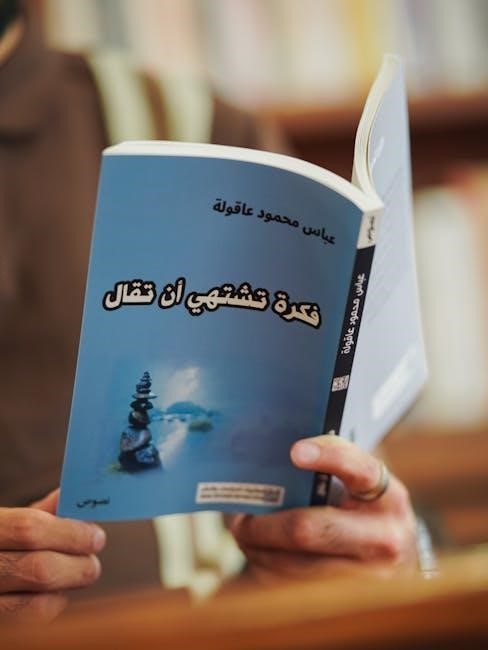The Mahabharata, an ancient Indian epic attributed to Vyasa, is a revered text exploring themes of dharma, karma, and morality․ Available as a PDF, it offers easy access to its profound teachings and intricate narratives, making it a timeless resource for spiritual and philosophical exploration․
Overview of the Mahabharata as a Literary Epic
The Mahabharata is one of the longest and most complex epics in world literature, spanning over 100,000 verses․ It is a rich tapestry of narratives, exploring themes of duty, morality, and destiny․ The epic revolves around the rivalry between the Pandavas and Kauravas, culminating in the devastating Kurukshetra war․ Its literary depth lies in its exploration of human nature, ethical dilemmas, and philosophical inquiry․ The text is structured as a dialogue between the sage Vyasa and his disciple Vaisampayana, with numerous subplots and digressions that enrich its narrative complexity․ The Mahabharata is not just a story but a reflection of societal values, psychological insights, and spiritual truths, making it a masterpiece of ancient Indian literature․ Its enduring appeal lies in its ability to resonate with readers across generations․
Importance of the Mahabharata in Indian Culture
The Mahabharata holds a paramount position in Indian culture, shaping its ethical, social, and philosophical foundations․ It is revered as both a literary masterpiece and a spiritual guide, influencing art, literature, and daily life for centuries․ The epic’s teachings on dharma, karma, and moral conduct have deeply ingrained themselves in Indian thought․ Its stories and characters, such as Krishna and Arjuna, are iconic symbols of wisdom and duty․ The Mahabharata is also a cornerstone of Hindu philosophy, with the Bhagavad Gita at its core offering insights into life’s purpose and ethical decision-making․ Its influence extends beyond religion to art, cinema, and even political discourse, making it a cultural touchstone that continues to resonate across generations․ Its relevance endures, bridging ancient traditions with modern interpretations․
Why the Mahabharata is Relevant in Modern Times
The Mahabharata remains remarkably relevant in modern times due to its universal themes and timeless wisdom․ Its exploration of human nature, ethical dilemmas, and moral choices resonates deeply in today’s complex world․ The epic addresses issues like ambition, greed, and the consequences of unchecked power, which are as pertinent now as they were millennia ago․ Additionally, its emphasis on dharma, or righteous living, offers guidance for navigating personal and professional challenges․ The Bhagavad Gita, a central text within the Mahabharata, provides profound insights into stress management, self-reflection, and achieving inner peace, making it a sought-after resource for modern seekers of mental and spiritual well-being․ Its adaptability across cultures and generations underscores its enduring appeal and relevance in contemporary society․

Key Themes and Moral Lessons
The Mahabharata explores themes of dharma, karma, and morality, offering timeless lessons on duty, honor, and the struggle between good and evil, guiding ethical decision-making․
The Concept of Dharma in the Mahabharata
Dharma, a central theme in the Mahabharata, signifies righteous living, duty, and moral order․ It guides individuals through complex ethical dilemmas, emphasizing adherence to one’s responsibilities and societal norms․ The epic illustrates dharma through characters like Yudhishthira, who embodies unwavering integrity, and Arjuna, who confronts moral conflicts in the Bhagavad Gita․ Dharma is not static; it adapts to circumstances, teaching balance between personal principles and societal expectations․ This concept remains universally relevant, offering insights into leading a virtuous life amidst life’s challenges․
Morality and Ethics in the Epic
Morality and ethics are deeply intertwined in the Mahabharata, presenting a nuanced exploration of right and wrong․ The epic challenges simplistic notions of morality through characters like Krishna, who justifies unconventional actions for the greater good, and Duryodhana, who embodies unrelenting ambition․ The narrative often blurs the lines between virtue and vice, encouraging readers to reflect on their own ethical compass․ Key episodes, such as the disrobing of Draupadi and the Kurukshetra war, highlight the consequences of moral failures and the importance of upholding ethical principles․ These teachings remain timeless, offering guidance on navigating life’s moral complexities with wisdom and integrity․
The Role of Karma in Shaping Destiny
The Mahabharata profoundly explores the concept of karma, illustrating how actions shape destiny․ Characters like Draupadi and the Pandavas face trials due to their past deeds, while figures like Karna and Duryodhana confront consequences tied to their choices․ The epic emphasizes that karma operates impartially, influencing the trajectory of lives and the unfolding of events․ Even divine interventions, such as Krishna’s guidance, underscore the inevitability of karma’s role in determining outcomes․ The Kurukshetra war itself is depicted as a culmination of accumulated karma, leading to both destruction and the eventual establishment of dharma․ This theme reinforces the idea that moral accountability and the law of cause and effect are central to the epic’s philosophy․

Historical and Mythological Context
The Mahabharata, an ancient Indian epic, seamlessly blends myth and history, recounting the Kurukshetra war and divine interventions that shaped India’s cultural and spiritual landscape․
The Historical Background of the Mahabharata
The Mahabharata, one of India’s most revered epics, is rooted in ancient history, with its core narrative centered around the Kurukshetra war․ Composed over centuries, it blends historical events with mythological elements․ The epic is traditionally attributed to the sage Vyasa, with its final form compiled around 400 BCE to 400 CE․ It reflects the socio-political dynamics of ancient India, including the rise and fall of kingdoms and the evolution of dharma (duty)․ The text also incorporates philosophical discourses, such as the Bhagavad Gita, which have profoundly influenced Indian thought․ While debates persist about its historical accuracy, the Mahabharata remains a cornerstone of Indian culture, offering insights into the past while addressing universal themes of morality and justice․ Its historical and mythological layers continue to captivate scholars and readers alike․
Mythological Stories and Their Significance
The Mahabharata is a tapestry of mythological tales that convey profound truths and moral lessons․ Stories like the birth of Ganesha and the churning of the ocean illustrate cosmic struggles and divine interventions․ The narrative of Shakuntala and Dushyanta highlights themes of love, duty, and redemption․ The tale of Bhagavad Gita, where Krishna imparts wisdom to Arjuna, is central to the epic, emphasizing the importance of fulfilling one’s dharma․ These stories, rich in symbolism, serve as moral and ethical guides, shaping cultural and philosophical thought in India․ They also explore complex human emotions and the divine, making the Mahabharata a timeless source of wisdom and inspiration․
The Role of the Gita in the Mahabharata
The Bhagavad Gita, a pivotal section of the Mahabharata, is a profound dialogue between Prince Arjuna and Lord Krishna․ Facing a moral dilemma on the battlefield, Arjuna seeks guidance, and Krishna elucidates the path of dharma, karma, and selfless action․ The Gita’s teachings emphasize fulfilling one’s duty without attachment to outcomes, a core philosophy of Hinduism․ It explores the nature of reality, the self, and liberation, offering spiritual and ethical wisdom․ As part of the Mahabharata, the Gita provides a philosophical anchor, influencing Indian thought and culture․ Its universal message of selfless action and ethical living continues to inspire millions, making it a cornerstone of the epic’s timeless appeal and relevance in modern times․

Popular Versions and Translations
The Mahabharata is available in various translations, including the original Sanskrit by Ved Vyas, Gita Press’s Hindi version, and C․ Rajagopalachari’s English adaptation, ensuring accessibility for diverse readers․
The Original Sanskrit Version by Ved Vyas
The original Sanskrit version of the Mahabharata, authored by the revered sage Ved Vyas, is the foundational text of the epic․ It is considered the most authentic and detailed account, capturing the complexities of the narrative, philosophical debates, and moral dilemmas․ The Sanskrit version is divided into 18 parvas, each exploring different aspects of the story, from the genesis of the conflict to the culmination in the great war of Kurukshetra․ Its intricate language and poetic style have inspired countless interpretations and translations over centuries․ Despite its antiquity, the original Sanskrit text remains a primary source for scholars and enthusiasts alike, offering deep insights into ancient Indian philosophy and culture․ Its influence extends beyond literature, shaping art, religion, and societal values․

Modern Translations in English and Other Languages
Modern translations of the Mahabharata in English and other languages have made the epic accessible to a global audience․ These translations aim to preserve the essence of the original Sanskrit text while adapting it to contemporary readers․ Notable English translations include C․ Rajagopalachari’s abridged version and Bibek Debroy’s unabridged translation, which are widely acclaimed for their clarity and fidelity to the original․ Regional languages like Hindi, Telugu, and Malayalam also boast popular translations, ensuring the epic’s reach extends beyond linguistic boundaries․ These modern renditions bridge the gap between ancient wisdom and modern readers, offering a fresh perspective on timeless themes․ They cater to diverse audiences, from scholars to casual readers, ensuring the Mahabharata’s relevance endures in the digital age․

Comparative Analysis of Different Versions
A comparative analysis of various Mahabharata versions reveals intriguing differences and similarities, reflecting diverse interpretations and regional influences․ Translations in English and other languages often highlight unique thematic emphases, with some focusing on philosophical depth while others prioritize narrative flow․ Regional variations, such as those from southern India, sometimes include additional stories or alternate endings, enriching the epic’s complexity․ These differences underscore the Mahabharata’s dynamic nature, shaped by cultural and linguistic contexts․ Comparing versions not only illuminates their distinct perspectives but also deepens readers’ understanding of the text’s universal themes․ This analysis invites readers to explore the epic’s multifaceted identity, making it a rich subject for scholarly and personal reflection․

Notable Retellings and Interpretations
The Mahabharata has inspired numerous retellings, such as Maggi Lidchi-Grassi’s The Great Golden Sacrifice and MT Vasudevan Nair’s Randaamoozham, offering unique perspectives on its timeless narratives․
Perspective of Arjuna in the Mahabharata
Arjuna’s perspective in the Mahabharata is deeply personal and philosophical, shaped by his internal conflicts and divine guidance․ His iconic dialogue with Krishna in the Bhagavad Gita highlights his moral dilemmas and the quest for righteousness․ Arjuna’s narrative explores the tension between duty and compassion, making him a relatable and human character․ His journey from hesitation to resolve underscores the epic’s themes of dharma and self-discovery․ Modern interpretations often focus on Arjuna’s emotional and psychological depth, offering insights into human nature and ethical decision-making․ His story remains a cornerstone of the Mahabharata’s timeless appeal, resonating with readers across generations․
Draupadi’s Narrative and Its Significance
Draupadi’s narrative in the Mahabharata is a powerful exploration of female agency, resilience, and justice․ Her story, often symbolized by the disrobing incident, highlights themes of honor, loyalty, and the societal constraints faced by women․ As a central character, Draupadi’s perspective challenges traditional norms, making her a symbol of strength and moral courage․ Her relationship with the Pandavas and her unwavering commitment to dharma underscore her significance in the epic․ Modern retellings often focus on her emotional depth and the broader implications of her experiences, offering fresh insights into gender dynamics and societal expectations․ Draupadi’s narrative remains a vital part of the Mahabharata’s cultural and philosophical legacy, inspiring both reflection and admiration․
Bhimasena’s Role and Personality in the Epic
Bhimasena, the second Pandava, is renowned for his immense physical strength and unwavering loyalty․ His role in the Mahabharata is pivotal, as his bravery and combat skills prove decisive in battles․ Bhima’s personality is marked by his short temper and impulsive nature, yet he is deeply devoted to his family and dharma․ His iconic weapon, the mace, symbolizes his formidable power․ Bhima’s actions, such as defeating Jarasandha and slaying Dushasana, showcase his heroism․ Despite his aggression, he embodies a complex mix of ferocity and compassion, making him a multifaceted character․ Bhima’s narrative highlights themes of loyalty, courage, and the consequences of unchecked emotions, adding depth to the epic’s exploration of human nature and moral dilemmas․

Cultural and Philosophical Impact
The Mahabharata profoundly shapes Indian cultural identity and philosophy, influencing art, literature, and spirituality․ Its timeless moral dilemmas and ethical debates continue to inspire global philosophical thought and reflection․

Influence of the Mahabharata on Indian Philosophy
The Mahabharata has profoundly shaped Indian philosophy, particularly through its exploration of dharma, karma, and moral dilemmas․ Its teachings, especially the Bhagavad Gita, form the cornerstone of Hindu philosophy, emphasizing duty, morality, and spiritual growth․ The epic’s narratives provide frameworks for ethical reasoning, influencing thinkers and philosophers across generations․ Its concepts of righteousness, justice, and self-realization continue to inspire contemporary philosophical debates․ The Mahabharata’s universal themes, such as the struggle between good and evil, resonate deeply with Indian thought, making it a foundational text for understanding the country’s philosophical heritage․ Its influence extends beyond religion, shaping cultural and intellectual traditions that remain vital today․
Representation in Art, Literature, and Film
The Mahabharata has inspired countless adaptations across art, literature, and film, reflecting its enduring cultural significance․ In literature, works like MT Vasudevan Nair’s Randaamoozham reinterpret the epic from unique perspectives, while films and serials bring its stories to life for modern audiences․ Artistic depictions, such as sculptures and paintings, capture the epic’s iconic scenes and characters․ These representations not only preserve the Mahabharata’s legacy but also introduce it to new generations, ensuring its relevance in contemporary culture․ The epic’s versatility allows it to transcend traditional forms, making it a dynamic and evolving part of global storytelling․
Psychological Insights from the Epic
The Mahabharata offers profound psychological insights into human behavior, emotions, and decision-making․ Its characters, such as Arjuna’s dilemma in the Gita, explore internal conflicts and moral struggles․ Draupadi’s narrative reveals resilience and emotional depth, while Bhima’s anger management serves as a cautionary tale․ The epic delves into themes of ambition, loyalty, and self-discovery, providing lessons on balancing personal desires with societal expectations․ Modern readers can apply these insights to understand their own emotional and ethical challenges․ The Mahabharata’s psychological depth remains a timeless guide for navigating life’s complexities, making it a valuable resource for self-reflection and personal growth․

Academic and Analytical Approaches
Scholars employ structural analysis, comparative studies, and data-driven methods to dissect the Mahabharata, revealing its layered narratives, ethical dilemmas, and cultural significance․
Structural Analysis of the Mahabharata
The Mahabharata’s structure is a complex interplay of nested narratives, dialogues, and philosophical discourses․ Scholars analyze its layered composition, identifying key frameworks such as the outer frame of the snake sacrifice and the central story of the Pandavas and Kauravas․ The epic employs non-linear storytelling, with events often recounted through multiple perspectives․ This structure allows for diverse interpretations, blending history, mythology, and philosophy․ The inclusion of embedded texts like the Bhagavad Gita further enriches its depth․ Digital tools and data analysis now aid in mapping these intricate connections, revealing patterns in character interactions and thematic repetitions․ Such analyses highlight the Mahabharata’s mastery in weaving a tapestry of human experiences, making it a subject of enduring academic fascination․
Comparative Studies with Other Epics
Scholars often compare the Mahabharata with other global epics like the Iliad, Odyssey, and Gilgamesh, exploring shared themes of heroism, morality, and fate․ Unlike these, the Mahabharata’s complexity lies in its moral ambiguity and layered storytelling․ While the Ramayana focuses on idealized virtue, the Mahabharata delves into human frailties and ethical dilemmas․ Its sheer size and philosophical depth set it apart, blending history, mythology, and philosophy․ Comparative studies reveal how the Mahabharata’s exploration of dharma transcends cultural boundaries, offering universal insights․ Such analyses highlight its unique contribution to world literature, emphasizing its relevance beyond Indian traditions․
Data Analysis of the Mahabharata Text
Modern scholars employ data analysis techniques to explore the Mahabharata’s vast narrative, uncovering patterns and insights․ Digital tools enable text mining, identifying character frequencies and dialogue trends․ Network analysis maps relationships between characters, revealing hierarchical structures․ Quantitative methods highlight recurring themes like dharma and karma․ Researchers also analyze linguistic styles to trace authorship and historical layers․ Open-source projects, such as GitHub repositories, host datasets for collaborative study․ These approaches provide a fresh perspective on the epic, bridging ancient wisdom with contemporary technology․ Data analysis not only aids academic research but also makes the Mahabharata more accessible to a modern audience, ensuring its timeless appeal endures in the digital age․
The Mahabharata’s timeless appeal lies in its universal themes and philosophical depth․ Future scholarship will likely focus on modern adaptations and technological integrations, ensuring its relevance in the digital age․
Final Thoughts on the Mahabharata’s Timeless Appeal
The Mahabharata’s enduring relevance stems from its profound exploration of human nature, morality, and existential dilemmas․ Its intricate characters, such as Arjuna and Draupadi, resonate universally, offering insights into courage, duty, and resilience․ The epic’s philosophical depth, particularly through the Bhagavad Gita, continues to inspire spiritual and ethical reflections․ Its multifaceted narrative transcends cultural boundaries, making it a global treasure․ As a PDF, the Mahabharata remains accessible, ensuring its timeless wisdom reaches modern audiences․ Its ability to adapt to contemporary interpretations while preserving ancient truths underscores its unparalleled influence․ The Mahabharata’s appeal lies in its capacity to evoke introspection and guide individuals through life’s complexities, solidifying its place as a literary and philosophical masterpiece․
Emerging Trends in Mahabharata Scholarship
Current scholarship on the Mahabharata highlights innovative approaches, blending traditional analysis with modern methodologies․ Digital tools now enable deeper textual analysis, while interdisciplinary studies integrate psychology, sociology, and philosophy․ Translations into diverse languages, including English, broaden accessibility․ Scholars like Gurcharan Das explore moral dilemmas, resonating globally․ New perspectives, such as Draupadi’s narrative, offer fresh insights․ The epic’s relevance in modern contexts, like leadership and ethics, is increasingly studied․ Global collaborations and digital platforms foster a vibrant academic community, ensuring the Mahabharata remains a dynamic field of study, adapting to contemporary intellectual demands and cultural evolution․
